Prioritizing Protection and Restoration Areas Based on Ecological Security Pattern with Different Resistance Assignments
Abstract
1. Introduction
2. Materials and Methods
2.1. Study Area
2.2. Data Sources and Pre-Processing
2.3. Methods
2.3.1. Identifying Ecological Sources
2.3.2. Constructing Resistance Surfaces Based on Different Resistance Assignment Methods
2.3.3. Extracting Ecological Corridors
2.3.4. Evaluating Importance of Ecological Sources and Corridors
2.3.5. Identifying Ecological Nodes
2.3.6. Determining Critical Ecological Areas for Protection and Restoration
3. Results
3.1. Spatial Distribution of Ecological Sources
3.1.1. Assessment of Habitat Quality
3.1.2. Identification and Analysis of Ecological Sources
3.2. Comparison of Ecological Corridors with Different Resistance Assignment Methods
3.2.1. Spatial Distribution of Resistance Surfaces and Corridors
3.2.2. Optimal Resistance Assignment Method Determination
3.3. Spatial Analysis for Key Ecological Areas
3.3.1. Spatial Distribution of Critical Areas for Protection
3.3.2. Spatial Distribution of Critical Areas for Restoration
4. Discussion
4.1. Effectiveness of Ecological Sources Identification
4.2. Variations in Resistance Surfaces and Corridors Resulting from Different Resistance Assignment Methods
4.3. Implications and Limitations
5. Conclusions
Author Contributions
Funding
Data Availability Statement
Acknowledgments
Conflicts of Interest
Appendix A
| Threat Factor | MAX_DIST (km) | Weight | Distance—Decay Function |
|---|---|---|---|
| Cropland | 1 | 0.6 | linear |
| Construction land | 6 | 1 | linear |
| Highways | 5 | 0.6 | exponential |
| Urban expressways | 4 | 0.5 | exponential |
| Primary roads | 3 | 0.4 | exponential |
| Secondary roads | 2 | 0.3 | exponential |
| Tertiary roads | 1 | 0.2 | exponential |
| Habitat Type | Habitat Suitability | Cropland | Construction Land | Highways | Urban Expressways | Primary Roads | Secondary Roads | Tertiary Roads |
|---|---|---|---|---|---|---|---|---|
| Cropland | 0.6 | 0 | 0.8 | 0.7 | 0.6 | 0.6 | 0.5 | 0.4 |
| Forestland | 1 | 0.6 | 0.9 | 0.8 | 0.7 | 0.7 | 0.6 | 0.5 |
| Grassland | 0.8 | 0.3 | 0.8 | 0.8 | 0.7 | 0.7 | 0.5 | 0.4 |
| water | 0.9 | 0.4 | 0.6 | 0.6 | 0.5 | 0.4 | 0.4 | 0.3 |
| Unutilized land | 0.3 | 0.1 | 0.3 | 0.5 | 0.3 | 0.2 | 0.2 | 0.1 |
| Construction land | 0 | 0 | 0 | 0.3 | 0.2 | 0.2 | 0.1 | 0.1 |
References
- Wei, L.; Zhou, L.; Sun, D.; Yuan, B.; Hu, F. Evaluating the impact of urban expansion on the habitat quality and constructing ecological security patterns: A case study of Jiziwan in the Yellow River Basin, China. Ecol. Indic. 2022, 145, 109544. [Google Scholar] [CrossRef]
- Kubacka, M.; Żywica, P.; Subirós, J.V.; Bródka, S.; Macias, A. How do the surrounding areas of national parks work in the context of landscape fragmentation? A case study of 159 protected areas selected in 11 EU countries. Land Use Policy 2022, 113, 105910. [Google Scholar] [CrossRef]
- Wang, R.; Zhu, Q.-C.; Zhang, Y.-Y.; Chen, X.-Y. Biodiversity at disequilibrium: Updating conservation strategies in cities. Trends Ecol. Evol. 2022, 37, 193–196. [Google Scholar] [CrossRef] [PubMed]
- Yao, S.; Li, Y.; Quan, X.; Xu, J. Applying the driver-pressure-state-impact-response model to ecological restoration: A case study of comprehensive zoning and benefit assessment in Zhejiang Province, China. Glob. Ecol. Conserv. 2024, 55, e03222. [Google Scholar] [CrossRef]
- Yu, K. Security patterns and surface model in landscape ecological planning. Landsc. Urban Plan. 1996, 36, 1–17. [Google Scholar] [CrossRef]
- Peng, J.; Liu, Y.; Corstanje, R.; Meersmans, J. Promoting sustainable landscape pattern for landscape sustainability. Landsc. Ecol. 2021, 36, 1839–1844. [Google Scholar] [CrossRef]
- Peng, J.; Xu, D.; Xu, Z.; Tang, H.; Jiang, H.; Dong, J.; Liu, Y. Ten key issues for ecological restoration of territorial space. Natl. Sci. Rev. 2024, 11, nwae176. [Google Scholar] [CrossRef]
- Fan, J. Theoretical innovation in optimization of protection and development of China’s territorial space and coping strategy of 13th Five-Year Plan. Bull. Chin. Acad. Sci 2016, 31. [Google Scholar] [CrossRef]
- Huang, L.; Wang, J.; Fang, Y.; Zhai, T.; Cheng, H. An integrated approach towards spatial identification of restored and conserved priority areas of ecological network for implementation planning in metropolitan region. Sustain. Cities Soc. 2021, 69, 102865. [Google Scholar] [CrossRef]
- Hou, W.; Zhai, L.; Walz, U. Identification of spatial conservation and restoration priorities for ecological networks planning in a highly urbanized region: A case study in Beijing-Tianjin-Hebei, China. Ecol. Eng. 2023, 187, 106859. [Google Scholar] [CrossRef]
- Gao, C.; Pan, H.; Wang, M.; Zhang, T.; He, Y.; Cheng, J.; Yao, C. Identifying priority areas for ecological conservation and restoration based on circuit theory and dynamic weighted complex network: A case study of the Sichuan Basin. Ecol. Indic. 2023, 155, 111064. [Google Scholar] [CrossRef]
- Gao, M.; Hu, Y.; Bai, Y. Construction of ecological security pattern in national land space from the perspective of the community of life in mountain, water, forest, field, lake and grass: A case study in Guangxi Hechi, China. Ecol. Indic. 2022, 139, 108867. [Google Scholar] [CrossRef]
- Weber, T.; Sloan, A.; Wolf, J. Maryland’s Green Infrastructure Assessment: Development of a comprehensive approach to land conservation. Landsc. Urban Plan. 2006, 77, 94–110. [Google Scholar] [CrossRef]
- Aminzadeh, B.; Khansefid, M. A case study of urban ecological networks and a sustainable city: Tehran’s metropolitan area. Urban Ecosyst. 2010, 13, 23–36. [Google Scholar] [CrossRef]
- Kong, F.; Yin, H.; Nakagoshi, N.; Zong, Y. Urban green space network development for biodiversity conservation: Identification based on graph theory and gravity modeling. Landsc. Urban Plan. 2010, 95, 16–27. [Google Scholar] [CrossRef]
- Wang, C.; Yu, C.; Chen, T.; Feng, Z.; Hu, Y.; Wu, K. Can the establishment of ecological security patterns improve ecological protection? An example of Nanchang, China. Sci. Total Environ. 2020, 740, 140051. [Google Scholar] [CrossRef] [PubMed]
- Regolin, A.L.; Oliveira-Santos, L.G.; Ribeiro, M.C.; Bailey, L.L. Habitat quality, not habitat amount, drives mammalian habitat use in the Brazilian Pantanal. Landsc. Ecol. 2021, 36, 2519–2533. [Google Scholar] [CrossRef]
- Liu, Y.; Huang, X.; Li, J.; Wang, Z.; Xu, C.; Xu, Y. Ecological connectivity analysis of typical coastal areas in China: The case of Zhangzhou City, Fujian Province. Urban Clim. 2024, 53, 101826. [Google Scholar] [CrossRef]
- Jiang, H.; Peng, J.; Dong, J.; Zhang, Z.; Xu, Z.; Meersmans, J. Linking ecological background and demand to identify ecological security patterns across the Guangdong-Hong Kong-Macao Greater Bay Area in China. Landsc. Ecol. 2021, 36, 2135–2150. [Google Scholar] [CrossRef]
- Lu, Y.; Huang, D.; Tong, Z.; Liu, Y.; He, J.; Liu, Y. A conceptual framework for constructing and evaluating directed ecological networks: Evidence from Wuhan Metropolitan Area, China. Environ. Impact Assess. Rev. 2024, 106, 107464. [Google Scholar] [CrossRef]
- Stevens, V.M.; Polus, E.; Wesselingh, R.A.; Schtickzelle, N.; Baguette, M. Quantifying functional connectivity: Experimental evidence for patch-specific resistance in the Natterjack toad (Bufo calamita). Landsc. Ecol. 2004, 19, 829–842. [Google Scholar] [CrossRef]
- Wei, J.; Zhang, Y.; Liu, Y.; Li, C.; Tian, Y.; Qian, J.; Gao, Y.; Hong, Y.; Liu, Y. The impact of different road grades on ecological networks in a mega-city Wuhan City, China. Ecol. Indic. 2022, 137, 108784. [Google Scholar] [CrossRef]
- Men, D.; Pan, J. Incorporating network topology and ecosystem services into the optimization of ecological network: A case study of the Yellow River Basin. Sci. Total Environ. 2024, 912, 169004. [Google Scholar] [CrossRef] [PubMed]
- Mu, H.; Li, X.; Ma, H.; Du, X.; Huang, J.; Su, W.; Yu, Z.; Xu, C.; Liu, H.; Yin, D. Evaluation of the policy-driven ecological network in the Three-North Shelterbelt region of China. Landsc. Urban Plan. 2022, 218, 104305. [Google Scholar] [CrossRef]
- Chen, C.; Wu, S.; Douglas, M.; Lü, M.; Wen, Z.; Jiang, Y.; Chen, J. Effects of changing cost values on landscape connectivity simulation. Acta Ecol. Sin. 2015, 35. [Google Scholar] [CrossRef]
- Ran, Y.; Lei, D.; Li, J.; Gao, L.; Mo, J.; Liu, X. Identification of crucial areas of territorial ecological restoration based on ecological security pattern: A case study of the central Yunnan urban agglomeration, China. Ecol. Indic. 2022, 143, 109318. [Google Scholar] [CrossRef]
- Pan, J.; Liang, J.; Zhao, C. Identification and optimization of ecological security pattern in arid inland basin based on ordered weighted average and ant colony algorithm: A case study of Shule River basin, NW China. Ecol. Indic. 2023, 154, 110588. [Google Scholar] [CrossRef]
- Peng, J.; Pan, Y.; Liu, Y.; Zhao, H.; Wang, Y. Linking ecological degradation risk to identify ecological security patterns in a rapidly urbanizing landscape. Habitat Int. 2018, 71, 110–124. [Google Scholar] [CrossRef]
- Peng, J.; Yang, Y.; Liu, Y.; Du, Y.; Meersmans, J.; Qiu, S. Linking ecosystem services and circuit theory to identify ecological security patterns. Sci. Total Environ. 2018, 644, 781–790. [Google Scholar] [CrossRef] [PubMed]
- McRae, B.H.; Beier, P. Circuit theory predicts gene flow in plant and animal populations. Proc. Natl. Acad. Sci. USA 2007, 104, 19885–19890. [Google Scholar] [CrossRef]
- Lan, Y.; Wang, J.; Liu, Q.; Liu, F.; Liu, L.; Li, J.; Luo, M. Identification of critical ecological restoration and early warning regions in the five-lakes basin of central Yunnan. Ecol. Indic. 2024, 158, 111337. [Google Scholar] [CrossRef]
- Sharp, R.; Tallis, H.; Ricketts, T.; Guerry, A.; Wood, S.; Chaplin-Kramer, R.; Nelson, E.; Ennaanay, D.; Wolny, S.; Olwero, N. InVEST 3.2. 0 user’s guide. Nat. Cap. Proj. 2015, 133. [Google Scholar] [CrossRef]
- Wei, Q.; Abudureheman, M.; Halike, A.; Yao, K.; Yao, L.; Tang, H.; Tuheti, B. Temporal and spatial variation analysis of habitat quality on the PLUS-InVEST model for Ebinur Lake Basin, China. Ecol. Indic. 2022, 145, 109632. [Google Scholar] [CrossRef]
- Zhang, H.; Zhang, C.; Hu, T.; Zhang, M.; Ren, X.; Hou, L. Exploration of roadway factors and habitat quality using InVEST. Transp. Res. Part D Transp. Environ. 2020, 87, 102551. [Google Scholar] [CrossRef]
- Balvanera, P.; Pfisterer, A.B.; Buchmann, N.; He, J.-S.; Nakashizuka, T.; Raffaelli, D.; Schmid, B. Quantifying the evidence for biodiversity effects on ecosystem functioning and services. Ecol. Lett. 2006, 9, 1146–1156. [Google Scholar] [CrossRef]
- Whitcomb, R.F.; Lynch, J.F.; Opler, P.A.; Robbins, C.S. Island biogeography and conservation: Strategy and limitations. Science 1976, 193, 1030–1102. [Google Scholar] [CrossRef]
- Gao, Y.; Ma, L.; Liu, J.; Zhuang, Z.; Huang, Q.; Li, M. Constructing ecological networks based on habitat quality assessment: A case study of Changzhou, China. Sci. Rep. 2017, 7, 46073. [Google Scholar] [CrossRef]
- Saura, S.; Pascual-Hortal, L. A new habitat availability index to integrate connectivity in landscape conservation planning: Comparison with existing indices and application to a case study. Landsc. Urban Plan. 2007, 83, 91–103. [Google Scholar] [CrossRef]
- Pascual-Hortal, L.; Saura, S. Integrating landscape connectivity in broad-scale forest planning through a new graph-based habitat availability methodology: Application to capercaillie (Tetrao urogallus) in Catalonia (NE Spain). Eur. J. For. Res. 2008, 127, 23–31. [Google Scholar] [CrossRef]
- Zhang, Q.; Tang, F.; Chen, H.; Li, F.; Chen, Z.; Jiao, Y. Assessing landscape fragmentation and ecological connectivity to support regional spatial planning: A case study of Jiangsu province, China. Ecol. Indic. 2024, 162, 112063. [Google Scholar] [CrossRef]
- Wang, C.; Wang, Q.; Liu, N.; Sun, Y.; Guo, H.; Song, X. The impact of LUCC on the spatial pattern of ecological network during urbanization: A case study of Jinan City. Ecol. Indic. 2023, 155, 111004. [Google Scholar] [CrossRef]
- Liang, G.; Niu, H.; Li, Y. A multi-species approach for protected areas ecological network construction based on landscape connectivity. Glob. Ecol. Conserv. 2023, 46, e02569. [Google Scholar] [CrossRef]
- Aizizi, Y.; Kasimu, A.; Liang, H.; Zhang, X.; Zhao, Y.; Wei, B. Evaluation of ecological space and ecological quality changes in urban agglomeration on the northern slope of the Tianshan Mountains. Ecol. Indic. 2023, 146, 109896. [Google Scholar] [CrossRef]
- Fu, Y.; Shi, X.; He, J.; Yuan, Y.; Qu, L. Identification and optimization strategy of county ecological security pattern: A case study in the Loess Plateau, China. Ecol. Indic. 2020, 112, 106030. [Google Scholar] [CrossRef]
- McRae, B.H.; Dickson, B.G.; Keitt, T.H.; Shah, V.B. Using circuit theory to model connectivity in ecology, evolution, and conservation. Ecology 2008, 89, 2712–2724. [Google Scholar] [CrossRef]
- Chen, X.; Kang, B.; Li, M.; Du, Z.; Zhang, L.; Li, H. Identification of priority areas for territorial ecological conservation and restoration based on ecological networks: A case study of Tianjin City, China. Ecol. Indic. 2023, 146, 109809. [Google Scholar] [CrossRef]
- McRae, B.H. Isolation by resistance. Evolution 2006, 60, 1551–1561. [Google Scholar] [CrossRef] [PubMed]
- Gu, T.; Tong, Y.; Wang, S.; You, Z.; Li, D.; Jiang, Y.; Rafaqat, A.; Wang, C.; Zhang, Q. Identifying the priority areas for ecological protection considering ecological connectivity and ecosystem integrity: A case study of Xianyang City, China. Ecol. Indic. 2024, 163, 112102. [Google Scholar] [CrossRef]
- Wang, N.; Zhao, Y. Construction of an ecological security pattern in Jiangnan water network area based on an integrated Approach: A case study of Gaochun, Nanjing. Ecol. Indic. 2024, 158, 111314. [Google Scholar] [CrossRef]
- Zhou, G.; Huan, Y.; Wang, L.; Lan, Y.; Liang, T.; Shi, B.; Zhang, Q. Linking ecosystem services and circuit theory to identify priority conservation and restoration areas from an ecological network perspective. Sci. Total Environ. 2023, 873, 162261. [Google Scholar] [CrossRef] [PubMed]
- Gurrutxaga, M.; Rubio, L.; Saura, S. Key connectors in protected forest area networks and the impact of highways: A transnational case study from the Cantabrian Range to the Western Alps (SW Europe). Landsc. Urban Plan. 2011, 101, 310–320. [Google Scholar] [CrossRef]
- Wang, J.; Bai, Y.; Huang, Z.; Ashraf, A.; Ali, M.; Fang, Z.; Lu, X. Identifying ecological security patterns to prioritize conservation and restoration: A case study in Xishuangbanna tropical region, China. J. Clean. Prod. 2024, 141222. [Google Scholar] [CrossRef]
- Liu, X.; Su, Y.; Li, Z.; Zhang, S. Constructing ecological security patterns based on ecosystem services trade-offs and ecological sensitivity: A case study of Shenzhen metropolitan area, China. Ecol. Indic. 2023, 154, 110626. [Google Scholar] [CrossRef]
- Foltête, J.-C.; Savary, P.; Clauzel, C.; Bourgeois, M.; Girardet, X.; Sahraoui, Y.; Vuidel, G.; Garnier, S. Coupling landscape graph modeling and biological data: A review. Landsc. Ecol. 2020, 35, 1035–1052. [Google Scholar] [CrossRef]
- Li, C.; Wu, Y.; Gao, B.; Zheng, K.; Wu, Y.; Wang, M. Construction of ecological security pattern of national ecological barriers for ecosystem health maintenance. Ecol. Indic. 2023, 146, 109801. [Google Scholar] [CrossRef]
- Peng, J.; Zhao, S.; Dong, J.; Liu, Y.; Meersmans, J.; Li, H.; Wu, J. Applying ant colony algorithm to identify ecological security patterns in megacities. Environ. Model. Softw. 2019, 117, 214–222. [Google Scholar] [CrossRef]
- Qian, M.; Huang, Y.; Cao, Y.; Wu, J.; Xiong, Y. Ecological network construction and optimization in Guangzhou from the perspective of biodiversity conservation. J. Environ. Manag. 2023, 336, 117692. [Google Scholar] [CrossRef]
- Xu, A.; Hu, M.; Shi, J.; Bai, Q.; Li, X. Construction and optimization of ecological network in inland river basin based on circuit theory, complex network and ecological sensitivity: A case study of Gansu section of Heihe River Basin. Ecol. Model. 2024, 488, 110578. [Google Scholar] [CrossRef]
- Brennan, A.; Naidoo, R.; Greenstreet, L.; Mehrabi, Z.; Ramankutty, N.; Kremen, C. Functional connectivity of the world’s protected areas. Science 2022, 376, 1101–1104. [Google Scholar] [CrossRef]
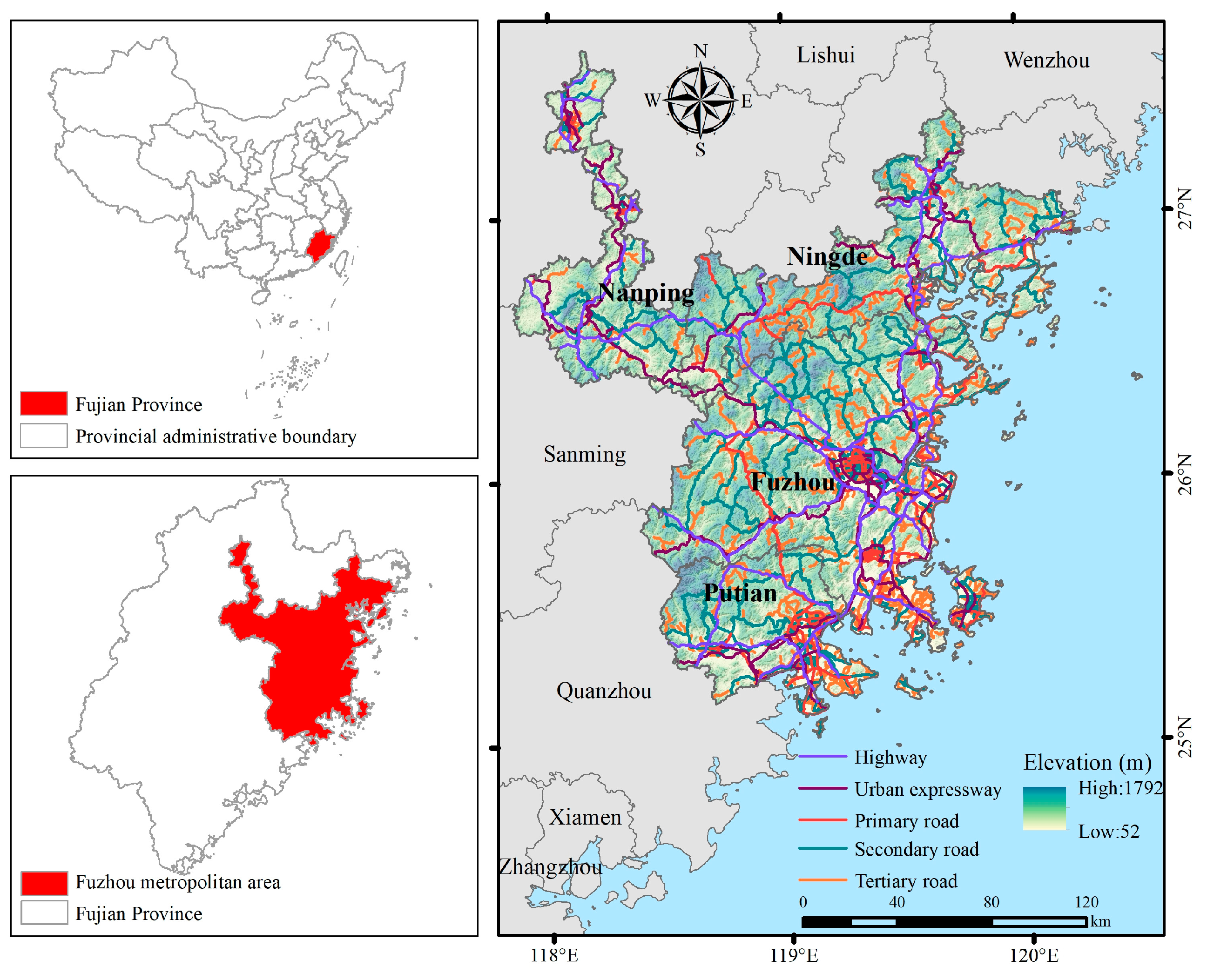
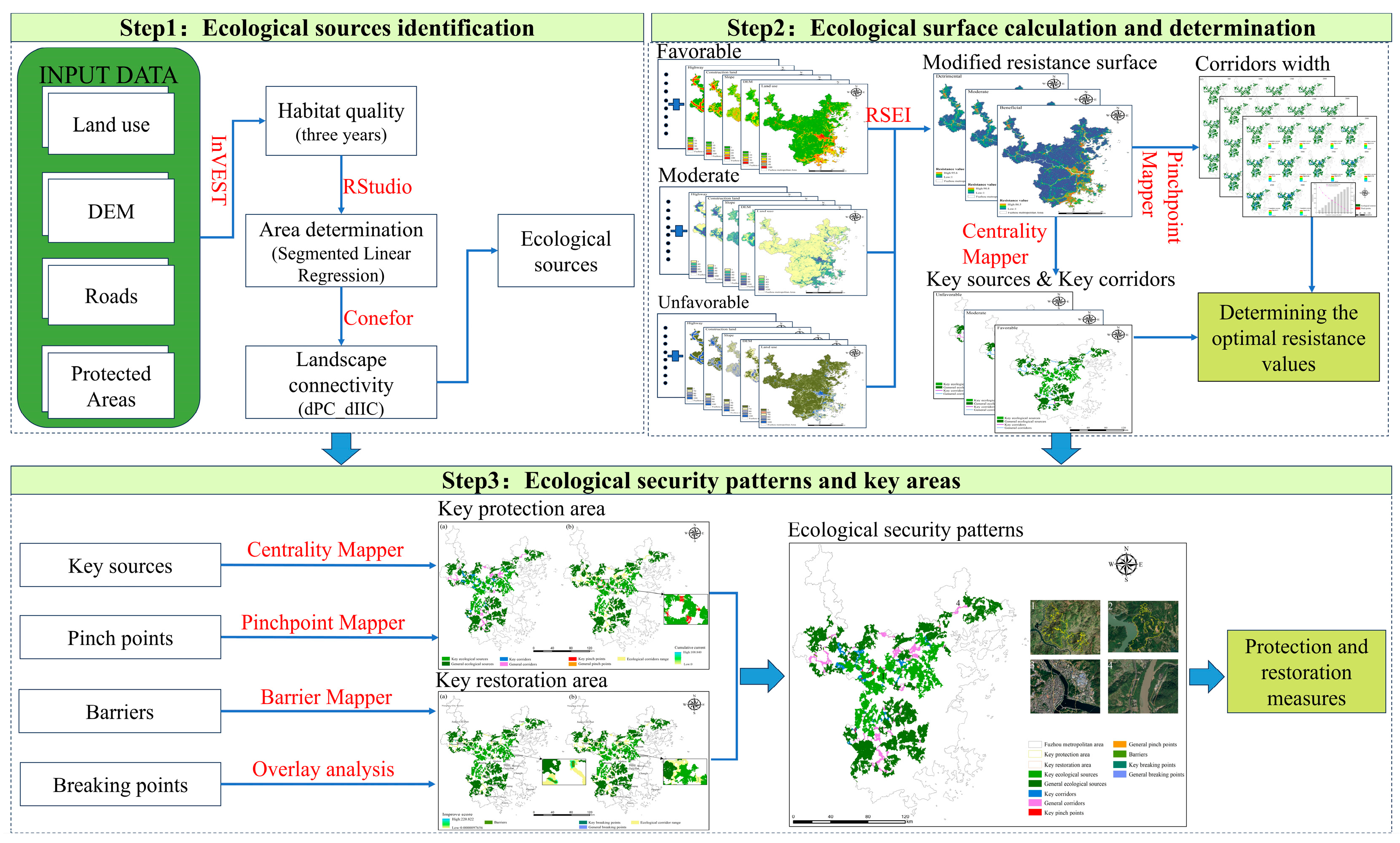

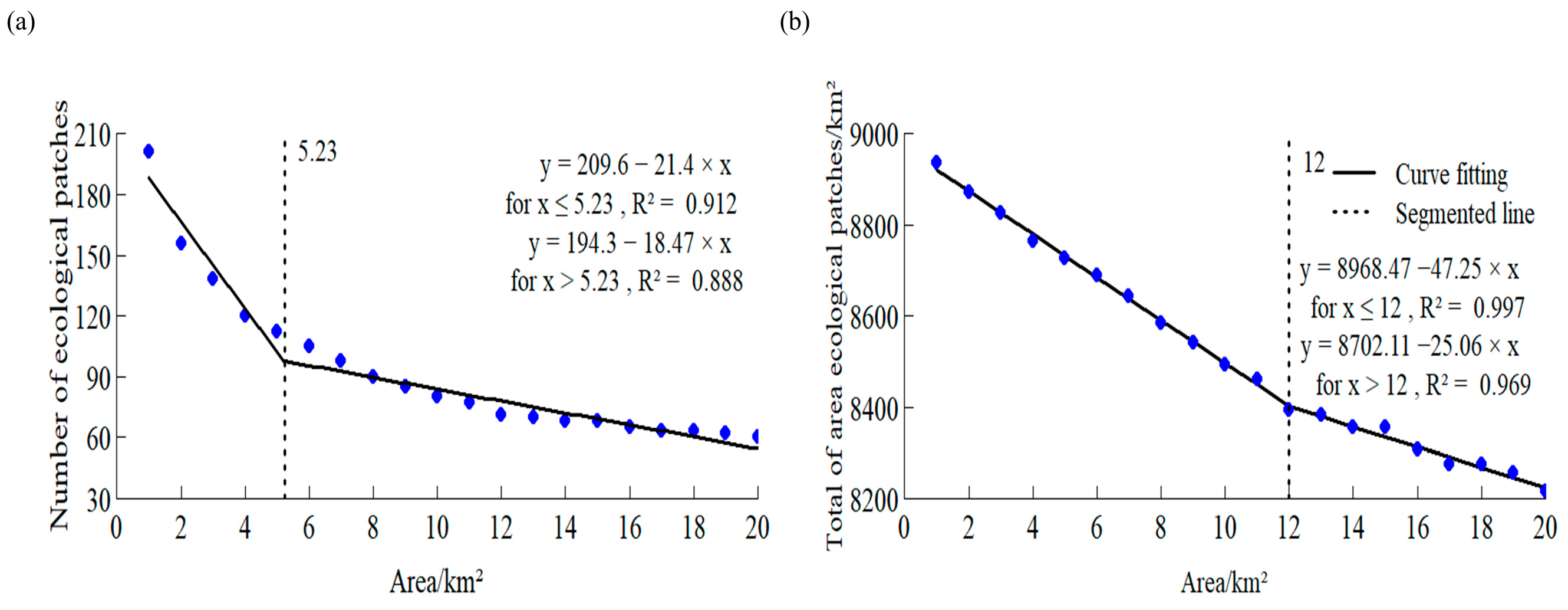

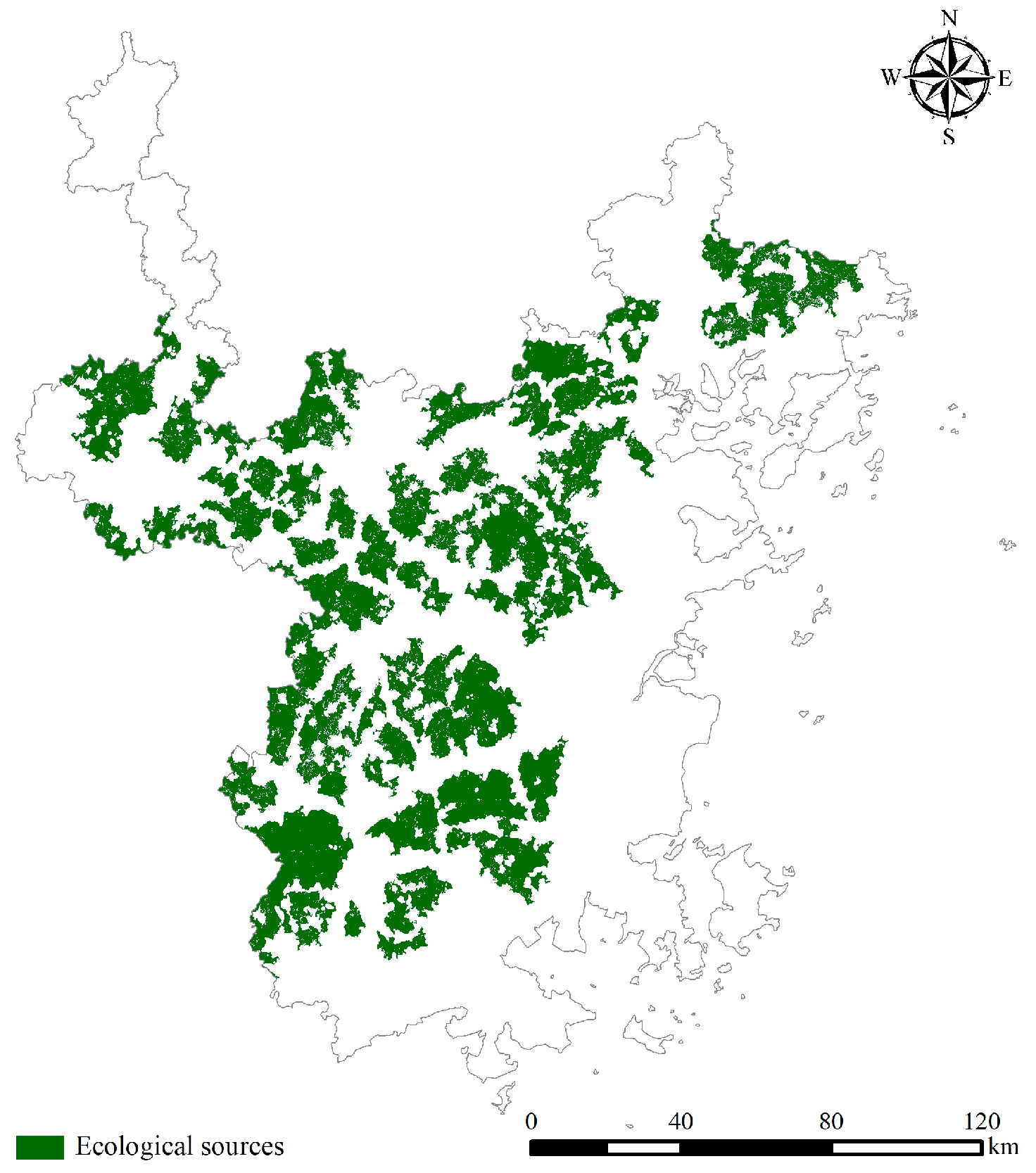
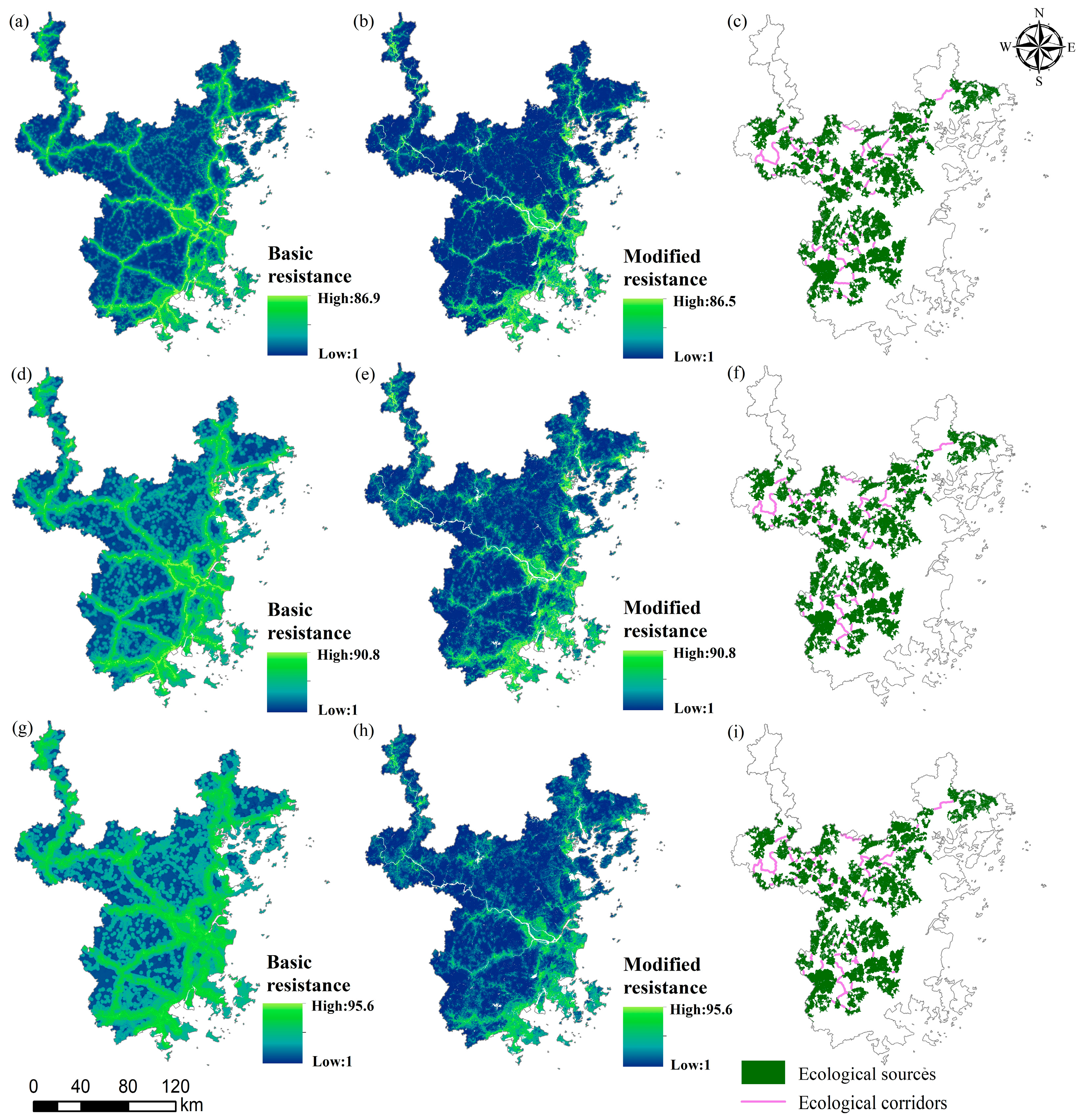
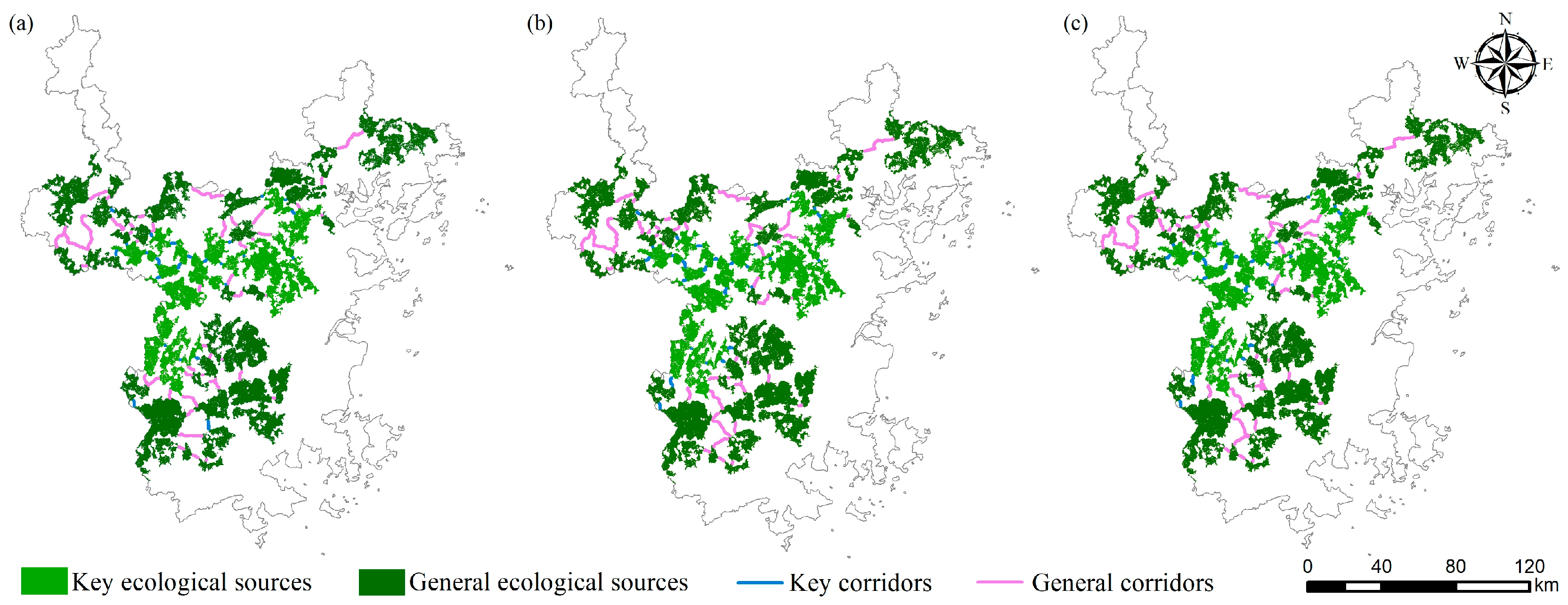
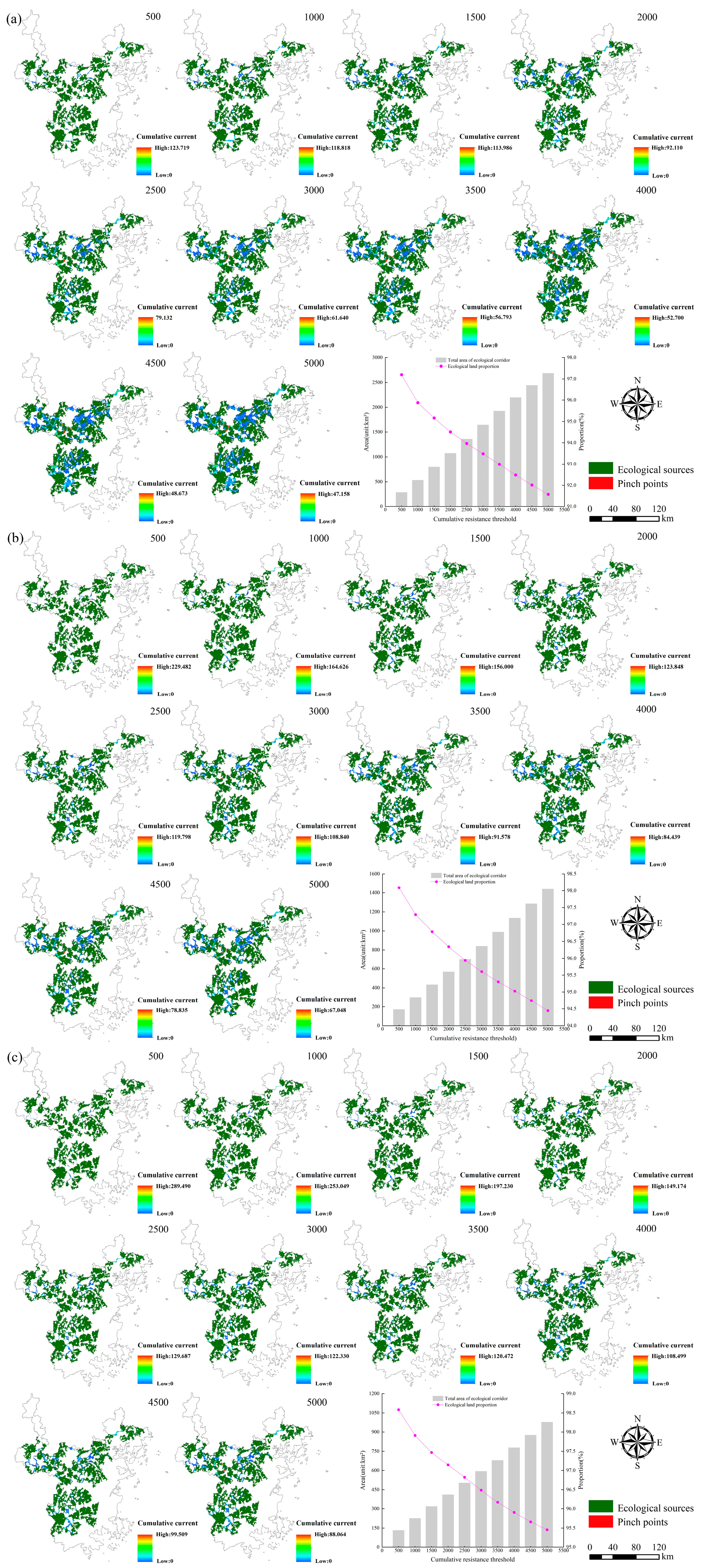
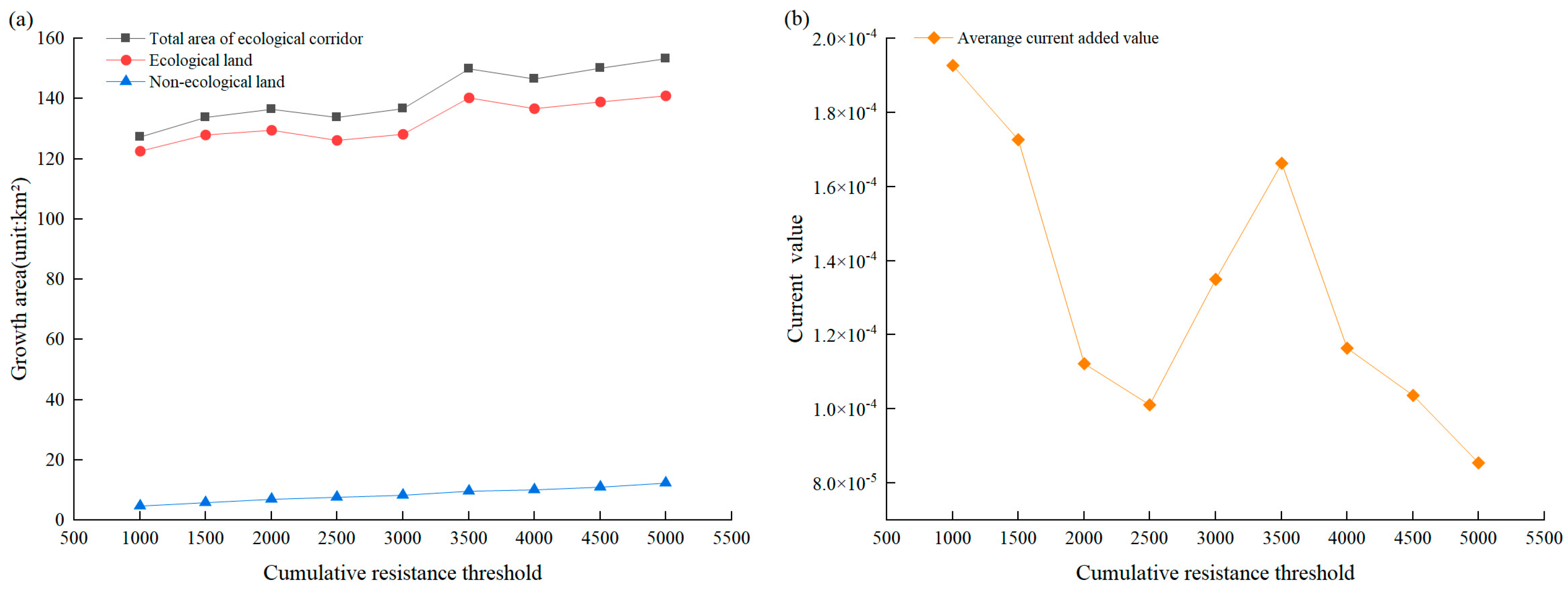
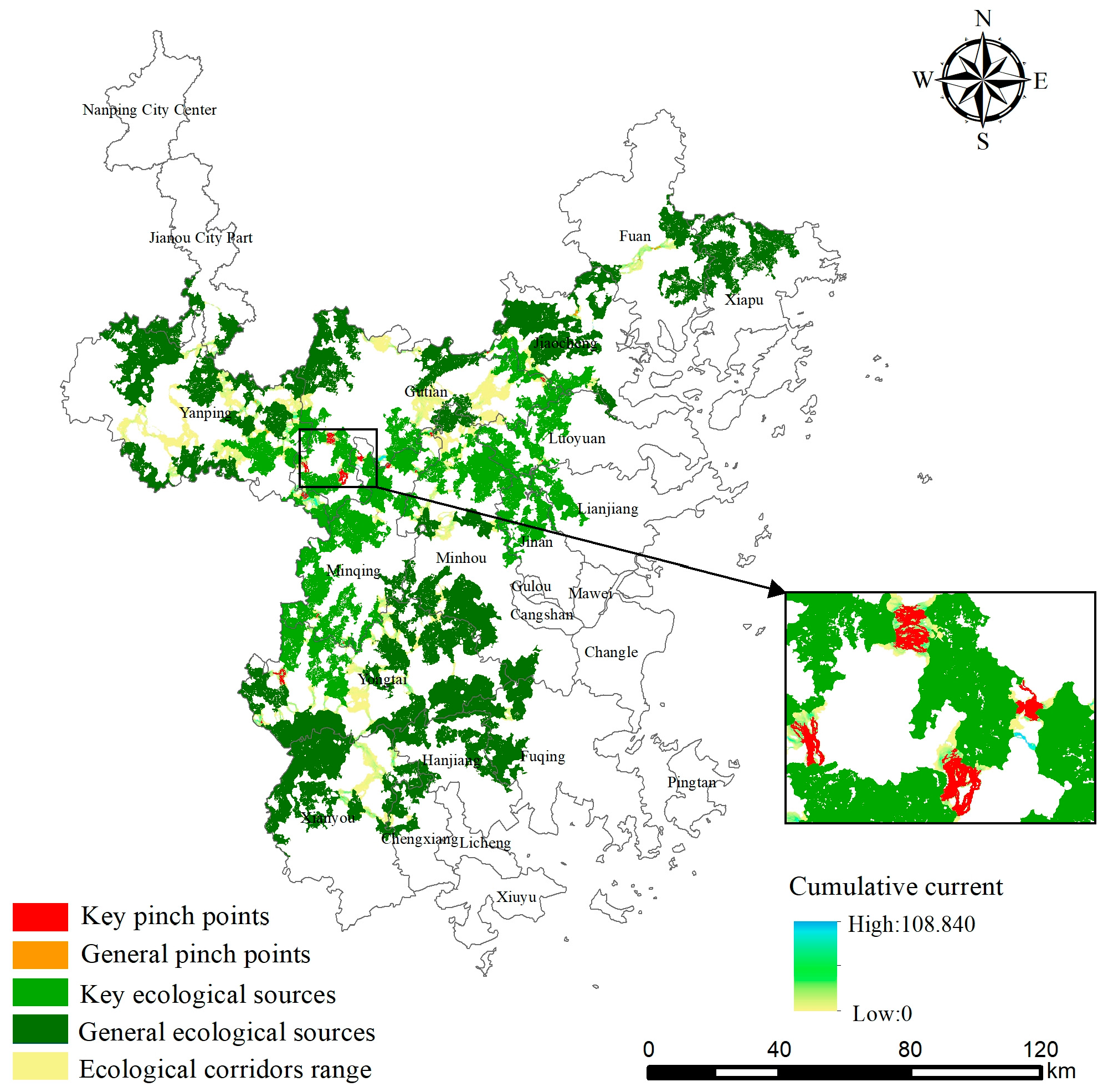
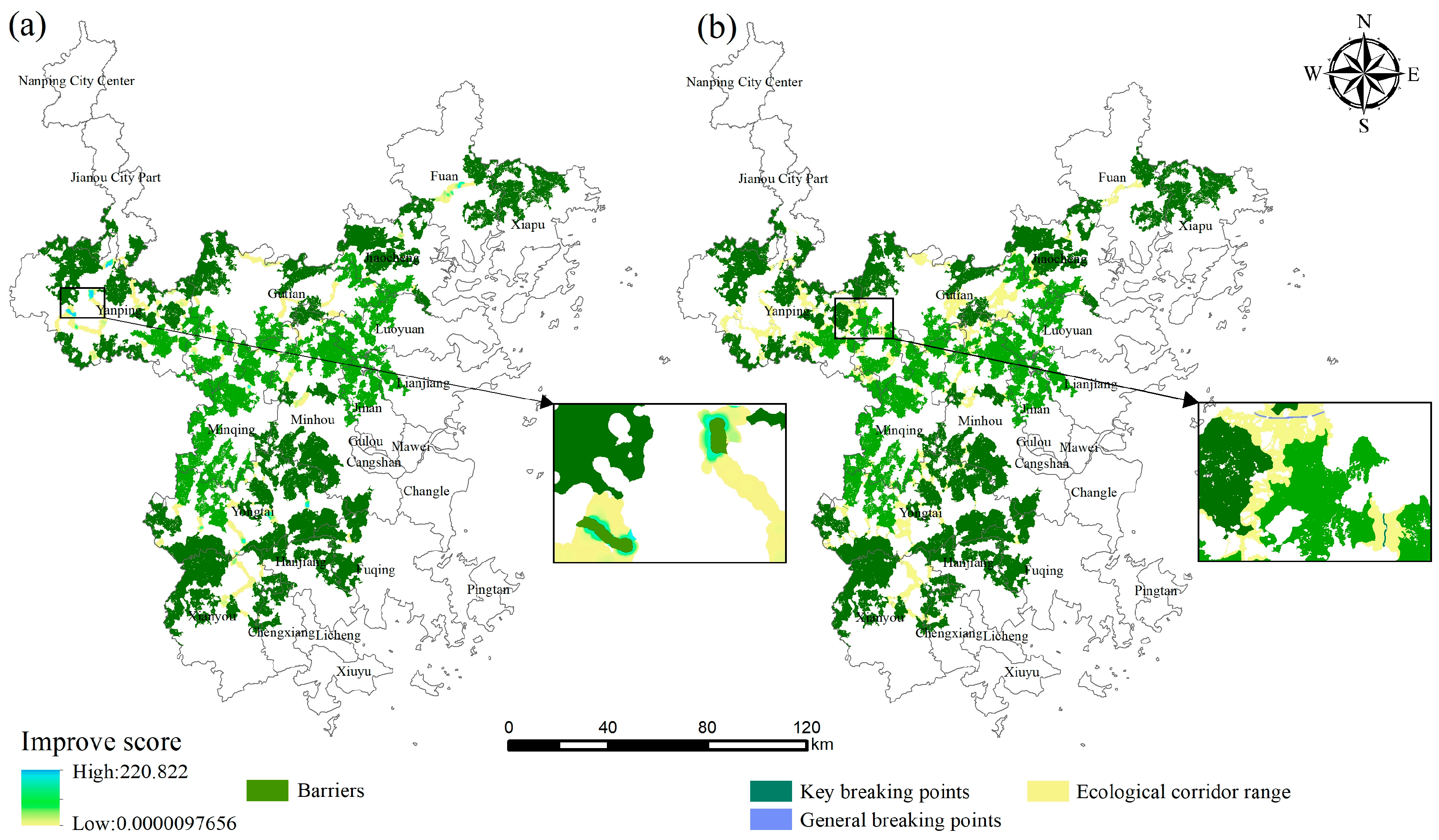
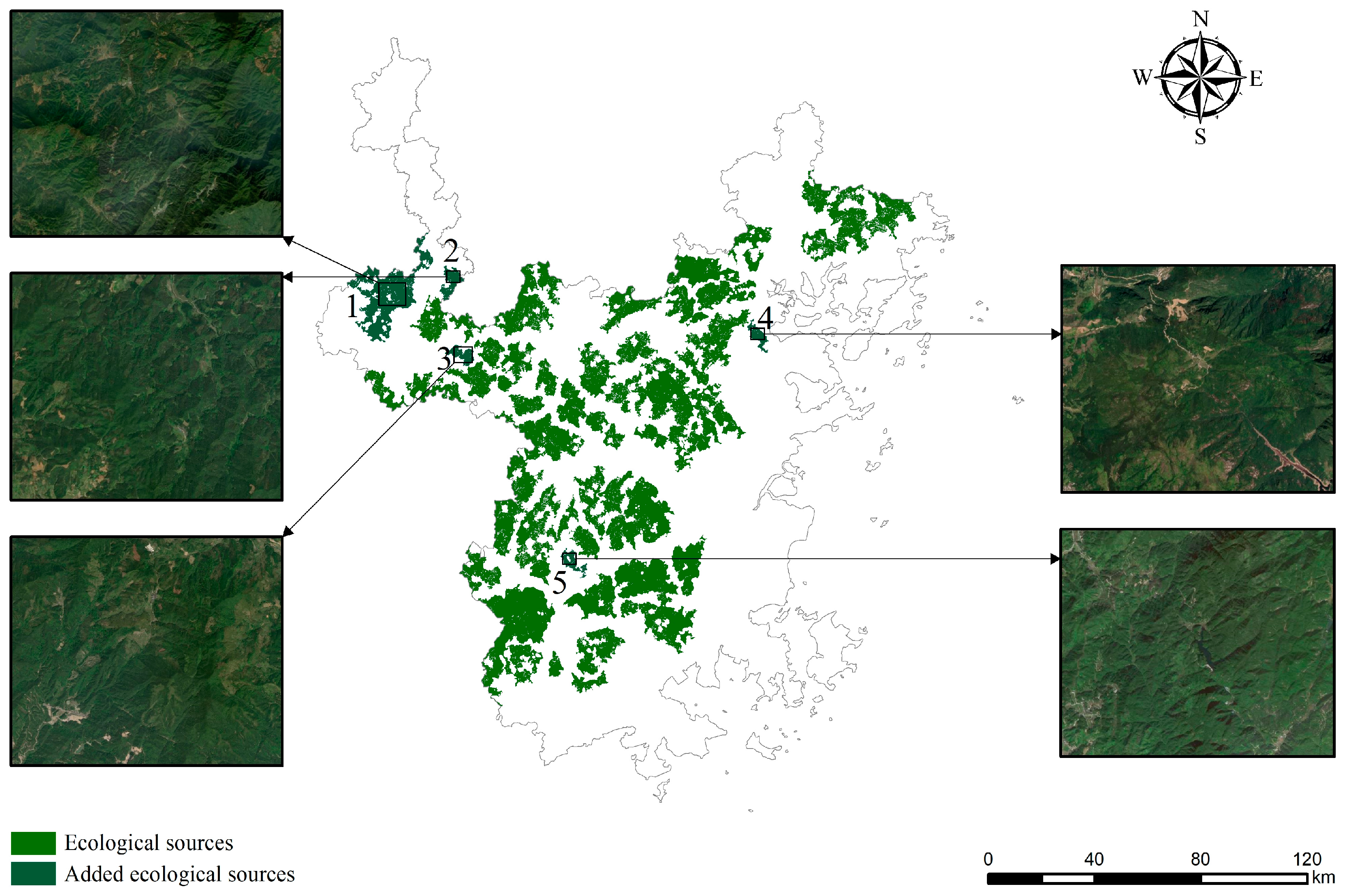
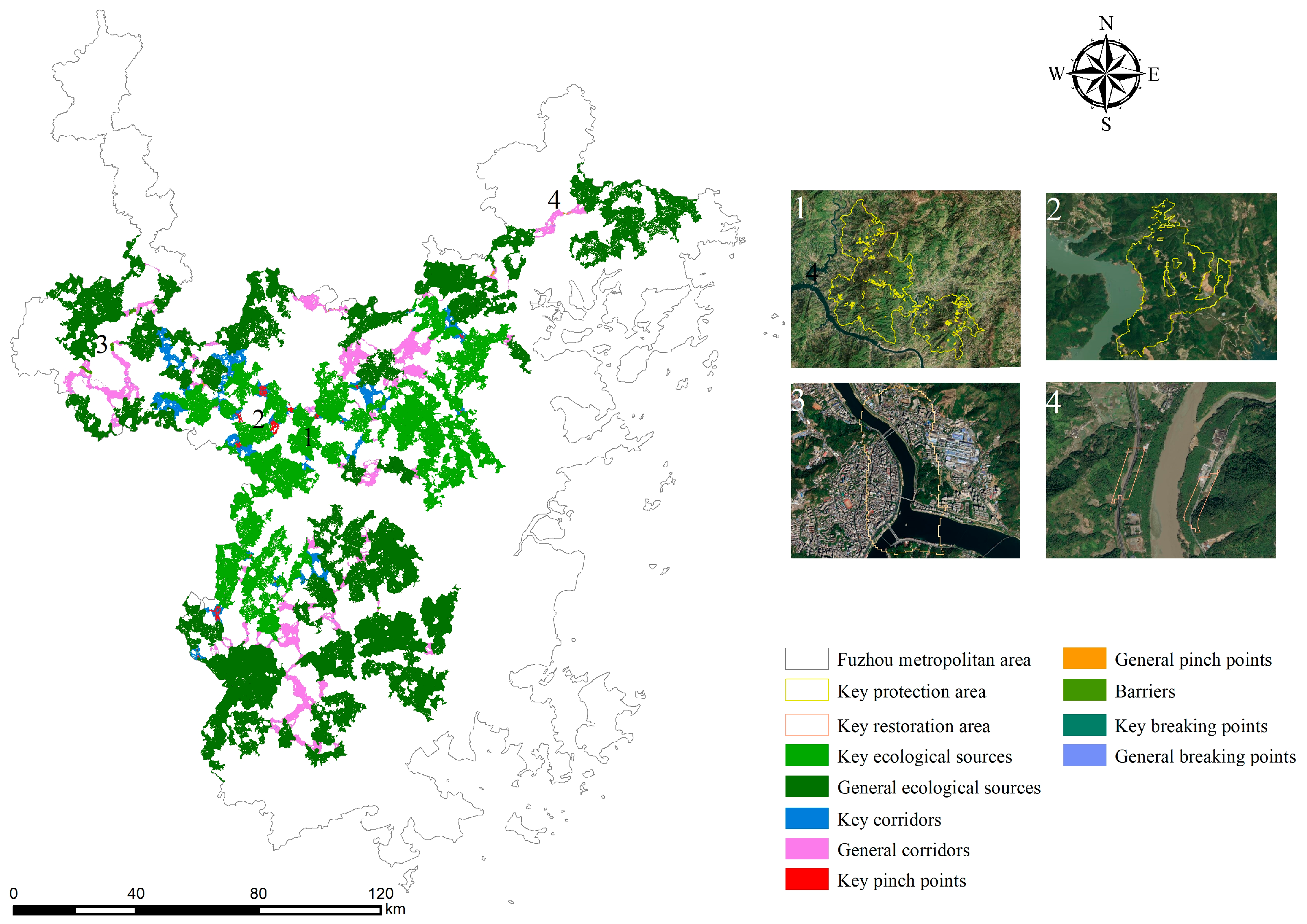
| Data | Application | Year | Resolution | Data Sources |
|---|---|---|---|---|
| Land-use type | Habitat quality calculation, Resistance surface construction | 2014 2018 2022 | 30 m | EU Open Research Repository https://zenodo.org/records/12779975, accessed on 15 June 2024 |
| Digital elevation model | Resistance surface construction | 2022 | 30 m | Geospatial Data Cloud https://www.gscloud.cn/ |
| Road | Habitat quality calculation, Resistance surface construction | 2022 | - | OpenStreetMap https://www.openstreetmap.org |
| Type | Formulas | Interpretation |
|---|---|---|
| Habitat quality calculation | (1) | Where Hj is the suitability of land-use type j; Dxj is the level of stress experienced by grid cell x within land-use type j; k is the half-saturation constant; Qxj is the habitat quality of grid cell x in land-use type j. |
| Landscape connectivity calculation | (2) | Where Sum is the total of standardized NC and standardized IIC. |
| (3) | Where n is the total number of patches; ai and aj are the areas of different patches i and j; nlij is the number of connections on the shortest path between patches i and j; AL is the extent of the study area; is defined as the maximum product probability of all possible paths between patches i and j. Where PCremove and IICremove correspond to the PC and IIC values, respectively, after the removal of a patch. dPC_IIC is the importance of patch i. | |
| (4) | ||
| (5) | ||
| (6) | ||
| (7) |
| Factors/Weight | Classification | Factors/Weight | Classification | Resistance Assignment Methods | ||
|---|---|---|---|---|---|---|
| Favorable | Moderate | Unfavorable | ||||
| Land-use type (0.15) | Forestland | - | - | 1 | 1 | 1 |
| Grassland | - | - | 10 | 30 | 60 | |
| Cropland | - | - | 20 | 40 | 70 | |
| Water | - | - | 30 | 50 | 80 | |
| Unutilized land | - | - | 40 | 60 | 90 | |
| Construction land | - | - | 100 | 100 | 100 | |
| Elevation (0.02) | <200 | Slope/° (0.02) | <5 | 1 | 1 | 1 |
| [200,500) | [5,15) | 10 | 40 | 70 | ||
| [500,800) | [15,25) | 20 | 50 | 80 | ||
| [800,1100) | [25,35) | 30 | 60 | 90 | ||
| ≥1100 | ≥35 | 100 | 100 | 100 | ||
| Dist. to construction land/m (0.28) | <150 | Dist. to highways/m (0.33) | <1000 | 100 | 100 | 100 |
| [150,500) | [1000,2000) | 30 | 60 | 90 | ||
| [500,1000) | [2000,3000) | 20 | 50 | 80 | ||
| [1000,1500) | [3000,4000) | 10 | 40 | 70 | ||
| ≥1500 | ≥4000 | 1 | 1 | 1 | ||
| Dist. to urban expressways/m (0.06) | <500 | Dist. to primary roads/m (0.04) | <300 | 100 | 100 | 100 |
| [500,1000) | [300,600) | 30 | 60 | 90 | ||
| [1000,1500) | [600,900) | 20 | 50 | 80 | ||
| [1500,2000) | [900,1200) | 10 | 40 | 70 | ||
| ≥2000 | ≥1200 | 1 | 1 | 1 | ||
| Dist. to secondary roads/m (0.06) | <100 | Dist. to tertiary roads/m (0.04) | <50 | 100 | 100 | 100 |
| [100,200) | [50,100) | 30 | 60 | 90 | ||
| [200,300) | [100,150) | 20 | 50 | 80 | ||
| [300,400) | [150,200) | 10 | 40 | 70 | ||
| ≥400 | ≥200 | 1 | 1 | 1 | ||
| Simples | Types | Characteristics | Land Use Status | Measures |
|---|---|---|---|---|
| 1 | Key patches | Patch fragmentation and severe habitat quality degradation | Forest land | Establish a forest quality monitoring system; develop adaptive plans to strengthen forest protection and management; implement degraded forest restoration projects; and restrict construction and development activities. |
| 2 | Key pinch points | Irreplaceable, prone to degradation and disappearance | Forest land, Cropland | Incorporate into ecological protection red lines, strictly prohibiting all development and construction activities; strengthen forest protection and management, plant native tree species, and increase species diversity. |
| 3 | Barriers | Actual fractures, corridor gaps | Construction land | Convert cropland back to forests and grasslands. |
| 4 | Key breaking points | Actual fractures, corridor gaps | Highways, Urban expressways | Construct wildlife passages, such as pipe culverts, bridge underpasses, and overpasses; erect warning signs; and monitor wildlife passages regularly using drones. |
Disclaimer/Publisher’s Note: The statements, opinions and data contained in all publications are solely those of the individual author(s) and contributor(s) and not of MDPI and/or the editor(s). MDPI and/or the editor(s) disclaim responsibility for any injury to people or property resulting from any ideas, methods, instructions or products referred to in the content. |
© 2025 by the authors. Licensee MDPI, Basel, Switzerland. This article is an open access article distributed under the terms and conditions of the Creative Commons Attribution (CC BY) license (https://creativecommons.org/licenses/by/4.0/).
Share and Cite
Jia, D.; Qiu, W.; Guo, R.; Wu, M.; Wang, Z.; Hu, X. Prioritizing Protection and Restoration Areas Based on Ecological Security Pattern with Different Resistance Assignments. Land 2025, 14, 349. https://doi.org/10.3390/land14020349
Jia D, Qiu W, Guo R, Wu M, Wang Z, Hu X. Prioritizing Protection and Restoration Areas Based on Ecological Security Pattern with Different Resistance Assignments. Land. 2025; 14(2):349. https://doi.org/10.3390/land14020349
Chicago/Turabian StyleJia, Dingyi, Weiguo Qiu, Rongpeng Guo, Min Wu, Zhanyong Wang, and Xisheng Hu. 2025. "Prioritizing Protection and Restoration Areas Based on Ecological Security Pattern with Different Resistance Assignments" Land 14, no. 2: 349. https://doi.org/10.3390/land14020349
APA StyleJia, D., Qiu, W., Guo, R., Wu, M., Wang, Z., & Hu, X. (2025). Prioritizing Protection and Restoration Areas Based on Ecological Security Pattern with Different Resistance Assignments. Land, 14(2), 349. https://doi.org/10.3390/land14020349






